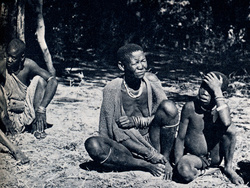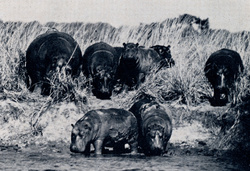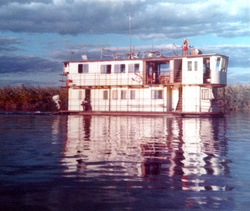Seven days of cruising the Okavango River Delta
Seven days of cruising the Okavango are filled with angling, nature impressions, enjoying each other and land excursions.

The swamps offer some of the best tiger-fishing in Africa, and we spent part of each day of the cruise catching some of these magnificent fighters. The Okavango River rises in Angola, and soon after entering Botswana it flows into the sandveld and splits into a vast inland delta that covers more than 7000 square miles in a country that is for the most part an arid semi-desert. The vast stretches of reeds and papyrus in the swamps form a natural filter, with the result that the delta water is so pure it can be used not only for drinking but also in car batteries. There is no pollution and no bilharzia. The average flow of the river is about 300 cusces, and most of this water evaporates over the entire delta system, a small proportion of it flowing through to Maun and the Lake Ngami area to the south. Some of it flows eastward towards the Makgadikgadi salt pan where it is being tapped for use at the Orapa diamond mines, on the second-biggest diamond pipe in the world. During our cruise the water-level in the swamps was exceptionally high, after some of the heaviest rains in memory over the entire Anglo-S.W.A.-Botswana area. With channel-blockages farther-south, which is where the big game is concentrated, we had to keep to the northern and north-eastern extremities of the swamps. What this area may lack in big game it makes up for in its abundance of bird-life and sheer beauty - and on one pleasantly warm winter's day after another we were able from Sitatunga's sun-deck to relish the panoramic views of this strange and silent world. In those seven days the only humans we saw were a handful of swamp-dwellers - descendants of the River Bushmen and the equally primitive Mumbukushu, and on some of the swamp-islands we landed on we found evidence of recent visits by these nomadic tribesmen who exist on fish and game and who move about the swamps in their hand-hewn makorros, or dugouts. But it is primarily to the hippos and crocodiles, the water-buck and otters, the eagles, the herons and egrets, the storks and cranes, the geese and ducks, the kingfishers and bee-eaters, darters, cormorants and the many other species of birds and beasts that this great wildlife kingdom belongs. And it is the fervent hope of the Liversedges and their associates that as much of it as possible should remain like this for all time, unspoilt by man in his never-ceasing quest for the resources he needs to further his own well-being. As Tim Liversedge, zoologist, former game warden, artist, photographer, writer and explorer put it to us: "Our main purpose in this venture is to provide information on the ecology of the vast Okavango delta system, in the hope that this may be of use to those who determine the future of this exotic area. "We hope to provide independent information to supplement that already being obtained, to enable changes to be made in a way least detrimental to this unique region." One only has to venture as we did into the little-known recesses of this great wildlife sanction to appreciate the raison d'etre for this admirable objective. (The End)
Addition:
On the 14th Jan 2023, over ten years after we published this then already historical travel report here, we received an email from author and former Zimbabwean farmer, Mark Milbank. He had taken part on the initial trip on the Sitatunga houseboat in 1973 and kindly shared new information with us:
Mark Milbank: I went with Tim and June Liversedge on the initial trial trip in the Sitatunga from Shakawe, beyond the Red cliffs and back to Shakawe in April 1973. I was then a partner in the Kenya based company, Abercrombie and Kent, so I then escorted 2 groups of American tourists on this magical boat. On these occasions we did not return to Shakawe but the tourists and I disembarked just beyond chief's Island and flew to Kasane, as the return journey is very slow and difficult. As far as I remember, Tim and June only ran these special safaris for 3 or 4 years before the Sitatunga was based at a permanent camp beyond the PAN HANDLE, where it was used for evening booze cruises and eventually caught fire and that was the end of it. This is a very brief pen picture of its life and my further memory is getting hazy but the initial trip that my family and I did with Tim was probably the best safari that I ever did as we visited areas, particularly in the Pan Handle, that no man had ever got to! I attach a photo of me standing on the 'top deck'.


